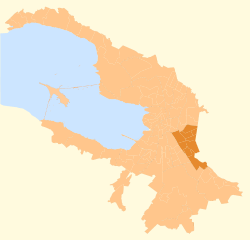Nevsky District
| Nevsky District Невский район (Russian) | |
|---|---|
 Nevsky District in St. Petersburg | |
| Coordinates: 59°52′N 30°28′E / 59.867°N 30.467°ECoordinates: 59°52′N 30°28′E / 59.867°N 30.467°E | |
|
Rossiysky Bridge over the Okkervil River in Nevsky District | |
| Location | |
| Country | Russia |
| Federal subject | federal city of St. Petersburg[1] |
| Statistics | |
| Area | 61.774 km2 (23.851 sq mi)[2] |
| Population (2010 Census) | 466,013 inhabitants[3] |
| Density | 7,543.84/km2 (19,538.5/sq mi)[4] |
| Time zone | MSK (UTC+03:00)[5] |
| Established | 1917[2] |
| Nevsky District on WikiCommons | |
Nevsky District (Russian: Не́вский райо́н) is a district of the federal city of St. Petersburg, Russia. As of the 2010 Census, its population was 466,013;[3] up from 438,061 recorded in the 2002 Census.[6]
Geography
The district is the only one in St. Petersburg to lie on both banks of the Neva River.[2] It borders with Krasnogvardeysky and Tsentralny Districts in the north, Vsevolozhsky District of Leningrad Oblast in the east, Kolpinsky District in the southeast, and with Frunzensky District in the west.[2]
History
The district was established in 1917.[2]
Municipal divisions
Nevsky District comprises the following nine municipal okrugs:[1]
- #54
- Ivanovsky
- Narodny
- Nevskaya Zastava
- Nevsky
- Obukhovsky
- Okkervil
- Pravoberezhny
- Rybatskoye
References
Notes
- 1 2 Law #411-68
- 1 2 3 4 5 Official website of the Administration of St. Petersburg. Nevsky District (Russian)
- 1 2 Russian Federal State Statistics Service (2011). "Всероссийская перепись населения 2010 года. Том 1" [2010 All-Russian Population Census, vol. 1]. Всероссийская перепись населения 2010 года (2010 All-Russia Population Census) (in Russian). Federal State Statistics Service. Retrieved June 29, 2012.
- ↑ The value of density was calculated automatically by dividing the 2010 Census population by the area specified in the infobox. Please note that this value is only approximate as the area specified in the infobox does not necessarily correspond to the area of the entity proper or is reported for the same year as the population.
- ↑ Правительство Российской Федерации. Федеральный закон №107-ФЗ от 3 июня 2011 г. «Об исчислении времени», в ред. Федерального закона №271-ФЗ от 03 июля 2016 г. «О внесении изменений в Федеральный закон "Об исчислении времени"». Вступил в силу по истечении шестидесяти дней после дня официального опубликования (6 августа 2011 г.). Опубликован: "Российская газета", №120, 6 июня 2011 г. (Government of the Russian Federation. Federal Law #107-FZ of June 31, 2011 On Calculating Time, as amended by the Federal Law #271-FZ of July 03, 2016 On Amending Federal Law "On Calculating Time". Effective as of after sixty days following the day of the official publication.).
- ↑ Russian Federal State Statistics Service (May 21, 2004). "Численность населения России, субъектов Российской Федерации в составе федеральных округов, районов, городских поселений, сельских населённых пунктов – районных центров и сельских населённых пунктов с населением 3 тысячи и более человек" [Population of Russia, Its Federal Districts, Federal Subjects, Districts, Urban Localities, Rural Localities—Administrative Centers, and Rural Localities with Population of Over 3,000] (XLS). Всероссийская перепись населения 2002 года [All-Russia Population Census of 2002] (in Russian). Retrieved August 9, 2014.
Sources
- Законодательное Собрание Санкт-Петербурга. Закон №411-68 от 25 июля 2005 г. «О территориальном устройстве Санкт-Петербурга», в ред. Закона №685-130 от 26 декабря 2014 г. «О внесении изменений в Закон Санкт-Петербурга "О территориальном устройстве Санкт-Петербурга" и Закон Санкт-Петербурга "О рассмотрении предложений о присвоении наименований географическим объектам"». Вступил в силу через 10 дней после дня официального опубликования, за исключением отдельных положений, вступающих в силу в иные сроки. Опубликован: "Новое в законодательстве Санкт-Петербурга", №22, 4 августа 2005 г. (Legislative Assembly of Saint Petersburg. Law #411-68 of July 25, 2005 On the Territorial Structure of Saint Petersburg, as amended by the Law #685-130 of December 26, 2014 On Amending the Law of Saint Petersburg "On the Territorial Structure of Saint Petersburg" and the Law of Saint Petersburg "On Considering the Suggestions to Assign Names to Geographical Objects". Effective as of after 10 days following the day of the official publication, with the exception of certain clauses taking effect on different dates.).
This article is issued from Wikipedia - version of the 5/19/2015. The text is available under the Creative Commons Attribution/Share Alike but additional terms may apply for the media files.
